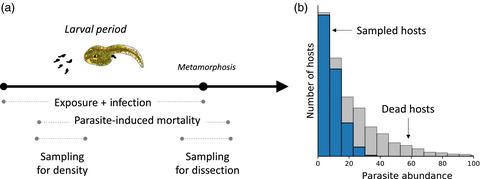当前位置:
X-MOL 学术
›
J. Anim. Ecol.
›
论文详情
Our official English website, www.x-mol.net, welcomes your
feedback! (Note: you will need to create a separate account there.)
Disease's hidden death toll: Using parasite aggregation patterns to quantify landscape‐level host mortality in a wildlife system
Journal of Animal Ecology ( IF 3.5 ) Pub Date : 2020-09-28 , DOI: 10.1111/1365-2656.13343 Mark Q Wilber 1 , Cheryl J Briggs 1 , Pieter T J Johnson 2
Journal of Animal Ecology ( IF 3.5 ) Pub Date : 2020-09-28 , DOI: 10.1111/1365-2656.13343 Mark Q Wilber 1 , Cheryl J Briggs 1 , Pieter T J Johnson 2
Affiliation

|
Worldwide, infectious diseases represent a major source of mortality in humans and livestock. For wildlife populations, disease-induced mortality is likely even greater, but remains notoriously difficult to estimate - especially for endemic infections. Approaches for quantifying wildlife mortality due to endemic infections have historically been limited by an inability to directly observe wildlife mortality in nature. Here, we address a question that can rarely be answered for endemic pathogens of wildlife: what are the population- and landscape-level effects of infection on host mortality? We combined laboratory experiments, extensive field data, and novel mathematical models to indirectly estimate the magnitude of mortality induced by an endemic, virulent trematode parasite (Ribeiroia ondatrae) on hundreds of amphibian populations spanning four native species. We developed a exible statistical model that uses patterns of aggregation in parasite abundance to infer host mortality. Our model improves on previous approaches for inferring host mortality from parasite abundance data by i.) relaxing restrictive assumptions on the timing of host mortality and sampling, ii.) placing all mortality inference within a Bayesian framework to better quantify uncertainty, and iii.) accommodating data from laboratory experiments and field sampling to allow for estimates and comparisons of mortality within and among host populations. Applying our approach to 301 amphibian populations, we found that trematode infection was associated with an average of between 13 and 40% population-level mortality. For three of the four amphibian species, our models predicted that some populations experienced >90% mortality due to infection, leading to mortality of thousands of amphibian larvae within a pond. At the landscape scale, the total number of amphibians predicted to succumb to infection was driven by a few high mortality sites, with fewer than 20% of sites contributing to greater than 80% of amphibian mortality on the landscape. The mortality estimates in this study provide a rare glimpse into the magnitude of effects that endemic parasites can have on wildlife populations and our theoretical framework for indirectly inferring parasite-induced mortality can be applied to other host-parasite systems to help reveal the hidden death toll of pathogens on wildlife hosts.
中文翻译:

疾病的隐藏死亡人数:使用寄生虫聚集模式量化野生动物系统中景观水平的宿主死亡率
在世界范围内,传染病是人类和牲畜死亡的主要来源。对于野生动物种群,疾病引起的死亡率可能更高,但仍然难以估计——尤其是地方性感染。由于地方性感染而量化野生动物死亡率的方法在历史上一直受到无法直接观察自然界中野生动物死亡率的限制。在这里,我们解决了一个对于野生动物的地方性病原体很少能回答的问题:感染对宿主死亡率的人口和景观水平影响是什么?我们结合实验室实验、广泛的现场数据和新的数学模型来间接估计由地方病引起的死亡率的大小,毒力吸虫寄生虫(Ribeiroia ondatrae)在跨越四种本地物种的数百个两栖动物种群上。我们开发了一个灵活的统计模型,该模型使用寄生虫丰度的聚集模式来推断宿主死亡率。我们的模型改进了以前从寄生虫丰度数据推断宿主死亡率的方法,方法是 i.) 放宽对宿主死亡率和采样时间的限制性假设,ii.) 将所有死亡率推断置于贝叶斯框架内,以更好地量化不确定性,以及 iii.)容纳来自实验室实验和现场采样的数据,以便估计和比较宿主种群内部和之间的死亡率。将我们的方法应用于 301 个两栖动物种群,我们发现吸虫感染与平均 13% 到 40% 的种群死亡率相关。对于四种两栖动物中的三种,我们的模型预测一些种群因感染而死亡 > 90%,导致池塘内成千上万的两栖动物幼虫死亡。在景观尺度上,预计死于感染的两栖动物总数是由几个高死亡率地点驱动的,只有不到 20% 的地点导致了景观中超过 80% 的两栖动物死亡率。本研究中的死亡率估计为地方性寄生虫对野生动物种群可能产生的影响程度提供了难得的一瞥,我们间接推断寄生虫引起的死亡率的理论框架可应用于其他宿主寄生虫系统,以帮助揭示隐藏的死亡人数野生动物宿主身上的病原体。我们的模型预测,一些种群因感染而死亡率超过 90%,导致池塘内成千上万的两栖动物幼虫死亡。在景观尺度上,预计死于感染的两栖动物总数是由几个高死亡率地点驱动的,只有不到 20% 的地点导致了景观中超过 80% 的两栖动物死亡率。本研究中的死亡率估计为地方性寄生虫对野生动物种群可能产生的影响程度提供了难得的一瞥,我们间接推断寄生虫引起的死亡率的理论框架可应用于其他宿主寄生虫系统,以帮助揭示隐藏的死亡人数野生动物宿主身上的病原体。我们的模型预测,一些种群因感染而死亡率超过 90%,导致池塘内成千上万的两栖动物幼虫死亡。在景观尺度上,预计死于感染的两栖动物总数是由几个高死亡率地点驱动的,只有不到 20% 的地点导致了景观中超过 80% 的两栖动物死亡率。本研究中的死亡率估计为地方性寄生虫对野生动物种群可能产生的影响程度提供了难得的一瞥,我们间接推断寄生虫引起的死亡率的理论框架可应用于其他宿主寄生虫系统,以帮助揭示隐藏的死亡人数野生动物宿主身上的病原体。在景观尺度上,预计死于感染的两栖动物总数是由几个高死亡率地点驱动的,只有不到 20% 的地点导致了景观中超过 80% 的两栖动物死亡率。本研究中的死亡率估计为地方性寄生虫对野生动物种群可能产生的影响程度提供了难得的一瞥,我们间接推断寄生虫引起的死亡率的理论框架可应用于其他宿主寄生虫系统,以帮助揭示隐藏的死亡人数野生动物宿主身上的病原体。在景观尺度上,预计死于感染的两栖动物总数是由几个高死亡率地点驱动的,只有不到 20% 的地点导致了景观中超过 80% 的两栖动物死亡率。本研究中的死亡率估计为地方性寄生虫对野生动物种群可能产生的影响程度提供了难得的一瞥,我们间接推断寄生虫引起的死亡率的理论框架可应用于其他宿主寄生虫系统,以帮助揭示隐藏的死亡人数野生动物宿主身上的病原体。
更新日期:2020-09-28
中文翻译:

疾病的隐藏死亡人数:使用寄生虫聚集模式量化野生动物系统中景观水平的宿主死亡率
在世界范围内,传染病是人类和牲畜死亡的主要来源。对于野生动物种群,疾病引起的死亡率可能更高,但仍然难以估计——尤其是地方性感染。由于地方性感染而量化野生动物死亡率的方法在历史上一直受到无法直接观察自然界中野生动物死亡率的限制。在这里,我们解决了一个对于野生动物的地方性病原体很少能回答的问题:感染对宿主死亡率的人口和景观水平影响是什么?我们结合实验室实验、广泛的现场数据和新的数学模型来间接估计由地方病引起的死亡率的大小,毒力吸虫寄生虫(Ribeiroia ondatrae)在跨越四种本地物种的数百个两栖动物种群上。我们开发了一个灵活的统计模型,该模型使用寄生虫丰度的聚集模式来推断宿主死亡率。我们的模型改进了以前从寄生虫丰度数据推断宿主死亡率的方法,方法是 i.) 放宽对宿主死亡率和采样时间的限制性假设,ii.) 将所有死亡率推断置于贝叶斯框架内,以更好地量化不确定性,以及 iii.)容纳来自实验室实验和现场采样的数据,以便估计和比较宿主种群内部和之间的死亡率。将我们的方法应用于 301 个两栖动物种群,我们发现吸虫感染与平均 13% 到 40% 的种群死亡率相关。对于四种两栖动物中的三种,我们的模型预测一些种群因感染而死亡 > 90%,导致池塘内成千上万的两栖动物幼虫死亡。在景观尺度上,预计死于感染的两栖动物总数是由几个高死亡率地点驱动的,只有不到 20% 的地点导致了景观中超过 80% 的两栖动物死亡率。本研究中的死亡率估计为地方性寄生虫对野生动物种群可能产生的影响程度提供了难得的一瞥,我们间接推断寄生虫引起的死亡率的理论框架可应用于其他宿主寄生虫系统,以帮助揭示隐藏的死亡人数野生动物宿主身上的病原体。我们的模型预测,一些种群因感染而死亡率超过 90%,导致池塘内成千上万的两栖动物幼虫死亡。在景观尺度上,预计死于感染的两栖动物总数是由几个高死亡率地点驱动的,只有不到 20% 的地点导致了景观中超过 80% 的两栖动物死亡率。本研究中的死亡率估计为地方性寄生虫对野生动物种群可能产生的影响程度提供了难得的一瞥,我们间接推断寄生虫引起的死亡率的理论框架可应用于其他宿主寄生虫系统,以帮助揭示隐藏的死亡人数野生动物宿主身上的病原体。我们的模型预测,一些种群因感染而死亡率超过 90%,导致池塘内成千上万的两栖动物幼虫死亡。在景观尺度上,预计死于感染的两栖动物总数是由几个高死亡率地点驱动的,只有不到 20% 的地点导致了景观中超过 80% 的两栖动物死亡率。本研究中的死亡率估计为地方性寄生虫对野生动物种群可能产生的影响程度提供了难得的一瞥,我们间接推断寄生虫引起的死亡率的理论框架可应用于其他宿主寄生虫系统,以帮助揭示隐藏的死亡人数野生动物宿主身上的病原体。在景观尺度上,预计死于感染的两栖动物总数是由几个高死亡率地点驱动的,只有不到 20% 的地点导致了景观中超过 80% 的两栖动物死亡率。本研究中的死亡率估计为地方性寄生虫对野生动物种群可能产生的影响程度提供了难得的一瞥,我们间接推断寄生虫引起的死亡率的理论框架可应用于其他宿主寄生虫系统,以帮助揭示隐藏的死亡人数野生动物宿主身上的病原体。在景观尺度上,预计死于感染的两栖动物总数是由几个高死亡率地点驱动的,只有不到 20% 的地点导致了景观中超过 80% 的两栖动物死亡率。本研究中的死亡率估计为地方性寄生虫对野生动物种群可能产生的影响程度提供了难得的一瞥,我们间接推断寄生虫引起的死亡率的理论框架可应用于其他宿主寄生虫系统,以帮助揭示隐藏的死亡人数野生动物宿主身上的病原体。









































 京公网安备 11010802027423号
京公网安备 11010802027423号